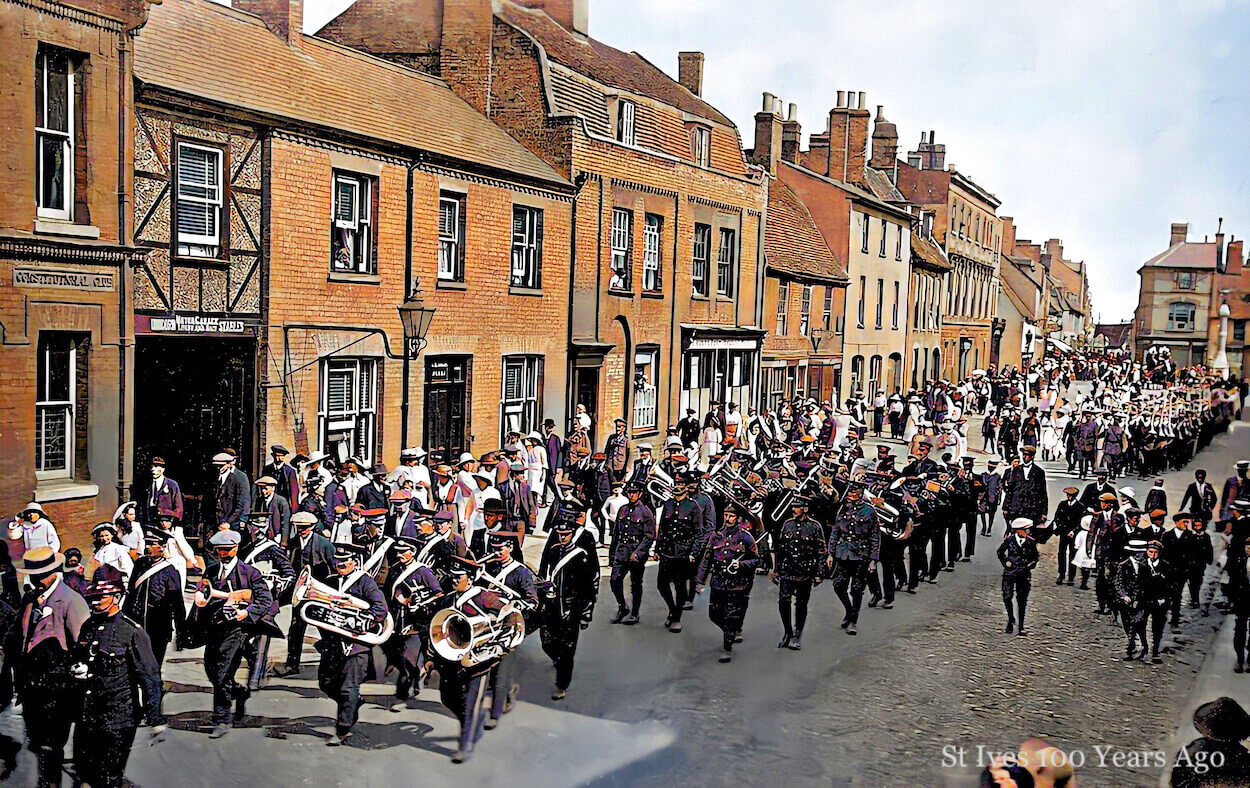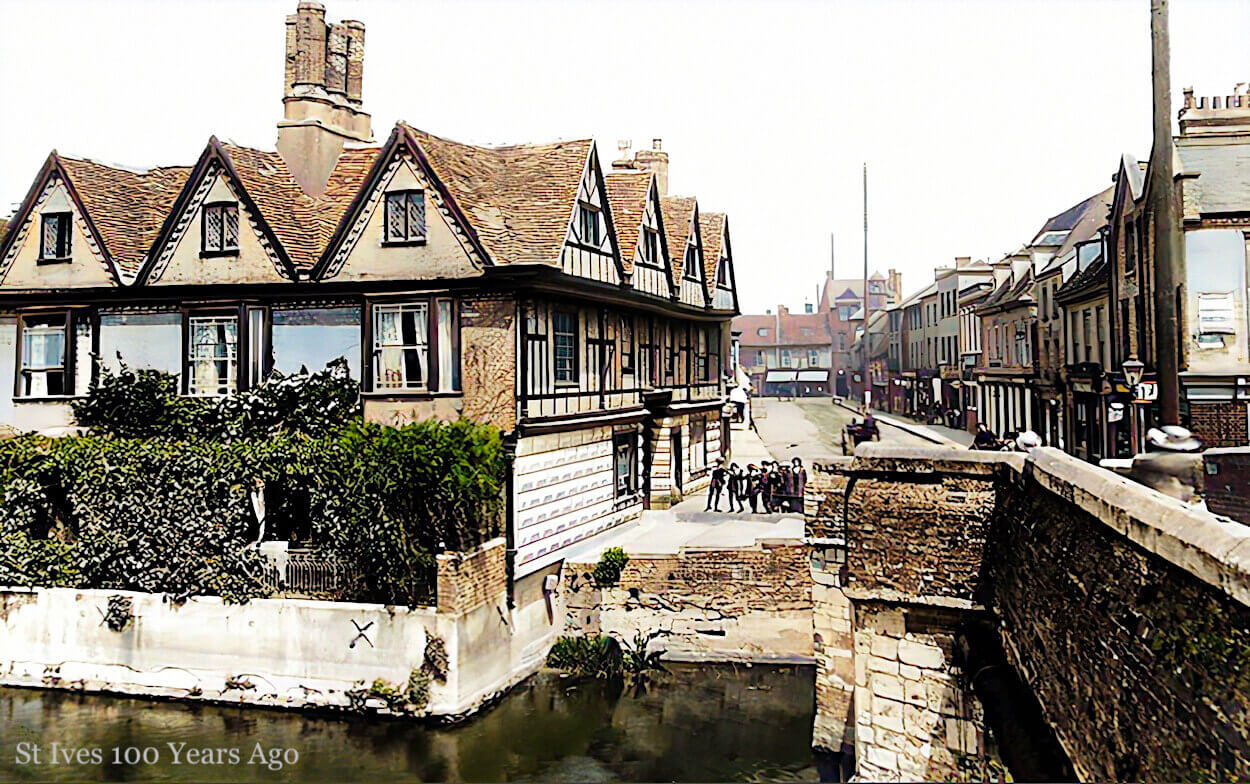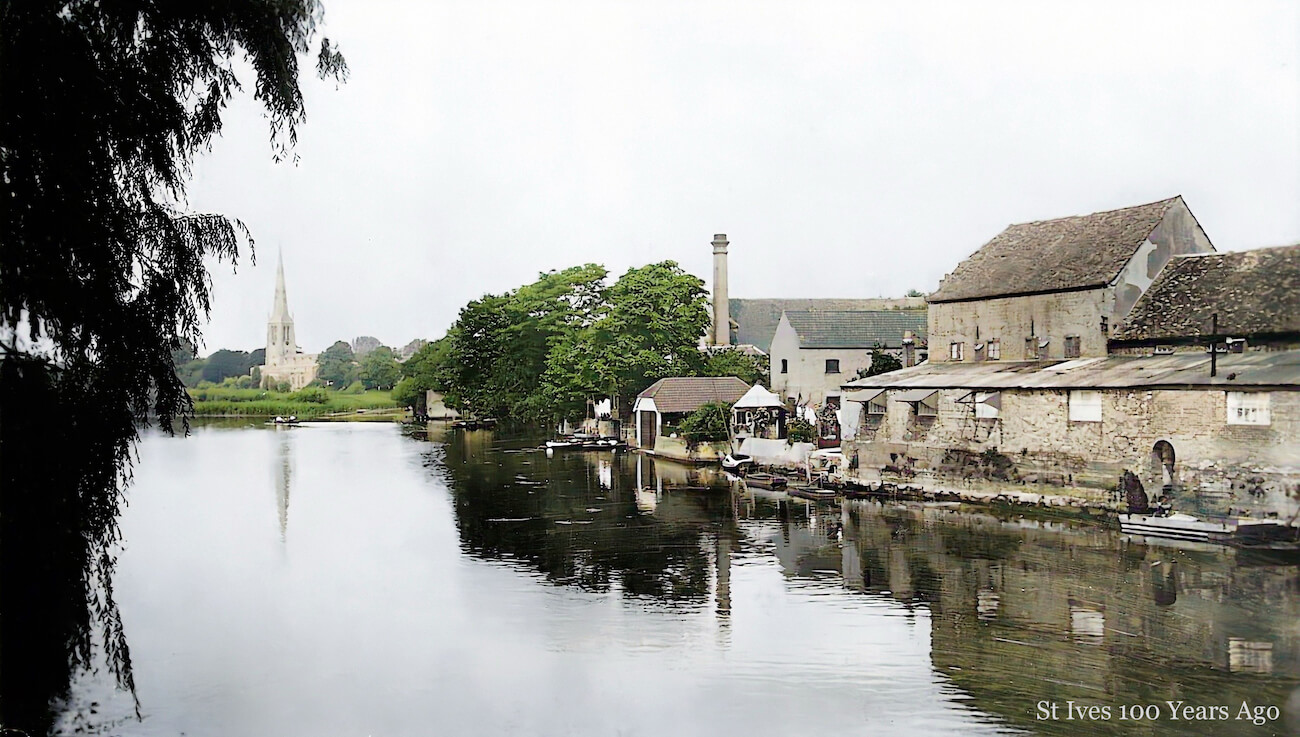St Ives Photo Album - 1910 to 1919
Barnes Walk and the Parish Church
 |
| Bathing Place, Holt Island, St Ives, 1913 |
Opening a place on Holt Island for safe swimming had been the subject of much discussion from the mid-1800s. Finally on 5 June 1913 the 'bathing place' was opened at a cost of £700 (today £81,000). The Hunts Post published an article of the opening on
13 June 1913.
 |
| Norris Knight's aircraft crashed in a garden in Barnes Walk, 1917. |
Aircraft became a more common sight in the skies over St Ives during WWI. They were also a danger. In September 1917 Norris Knight, a resident of the town, flew his
Farman Shorthorn low over the houses in
Filbert's Walk, showing off to his relatives the Harrisons, who lived there. Heading back towards
Wyton Airfield, he clipped the trees in Barnes Walk and nosedived into the garden of Barnes House. Norris was fortunate to come out of the crash unscathed. The Hunts Post reported the accident on
28 September 1917.
 |
| St Ives Parish Church without spire, 1918. |
Just six months later there was a much more serious air accident. On an evening in March 1918 Second Lieutenant Kenneth Wastell landed his
De Havilland DH6 aircraft in Hemingford Meadow to ask for directions. Aiming for a night out in St Ives, he most likely intended to leave his plane at Wyton Airfield. Having been given guidance, he turned the plane around, revved up the engine, took off and crashed into the Parish Church spire. The Board of Enquiry that followed could find no evidence of any fault in the aircraft. Evening mist or blindspots caused by the biplane's wings were suggested as causes. Inexperience was another possible factor. Kenneth, only 19 years old, was killed in the crash
In addition to lopping the top off the spire, the aircraft caused devastating damage to the church roof and interior. The spire collapsed into the north aisle and the aircraft fell into the south aisle. Although the church was insured, the original structure was in poor repair. It was decided to completely replace the damaged parts rather than merely repair. Only about half the £7,000 (today £813,000) rebuilding cost was covered by insurance. After a long campaign of fundraising the church was again used for services in 1920. It took until 1924 for the spire to be rebuilt, and it was 1930 before the bells were rehung and sounded across the town once again.
Cambridge Independent Press published a cut and paste photo of how the collapsing steeple must have looked on
30 March 1918, along with a more detailed report on
30 March 1918. The Hunts Post also reported the accident on
29 March 1918. The last section in this album showing aerial photos has two more of the damaged spire.
 |
| Angler's Rest guesthouse. For current view, click here. |
The Waits
 |
| Red Cross Hospital treating wounded soldiers in the Methodist Church Hall. |
Within days of WWI being declared a Red Cross Hospital was set up in the church hall of what was called at the time the Wesleyan Church. It had 15 beds and was the first to be officially recognised by the War Office. The Hunts Post reported on its opening on
4 September 1914.
The Broadway
 |
| The Fife & Forfar Yeomanry arrive in St Ives, August 1914. For current view, click here. |
 |
| The Fife & Forfar Yeomanry march in The Broadway, 1914. For current view, click here. |
On Saturday 29 August 1914 the Fife and Forfar Yeomanry marched into St Ives, welcomed by practically the whole town. Accommodation for men, horses and equipment had been prepared. Pub hours were restricted to 9pm and St Ivians warned if challenged 'Halt, who goes there?' they had to stop immediately or risk being fired upon.
Concerts were arranged, football and rugby matches took place between the troops and St Ives teams, the rugby being of particular interest since the Fife and Forfar side contained two Scottish Internationals. There were inspections and troop movements.
At midnight on Monday 9 November 1914 orders were received for the Fife and Forfars to decamp immediately to a secret location. As they marched away they were given a hearty send-off by the town.
The Hunts Post reported their arrival on
4 September 1914 and departure on
10 November 1914.
 |
| A recruitment drive in The Broadway, 1914. For current view, click here. |
There was huge pressure on the men of St Ives to sign up to war. Beside recruitment drives such as the one shown above, in 1915 the Hunts Post ran a series of images attempting to shame men into enlisting. The worst of these was aimed at fathers of young children, to view
click here.
Bridge Street
 |
| Scots Greys in Bridge Street 1912. For current view, click here. |
Even before the start of WWI there were Army manoeuvres in Hemingford Meadow. In the image above the Scots Greys parade down Bridge Street.
 |
| Bridge Street c1910. For current view, click here. |
Note the clock tower in the centre of the photograph, erected in 1802 over Kiddle's shop. It was dismantled in 1922 after becoming unsafe. There's an image of the dismantling work in the
St Ives Photo Album - 1920 to 1939.
 |
| Bridge Street, c1910. For current view, click here. |
 |
| Bridge Street, c1914. |
 |
| Bridge Street, c1914. |
St Ives bridge
 |
| St Ives bridge and chapel, with The Dolphin Inn on the far side. For current view, click here. |
 |
| St Ives bridge and chapel from the other side, the Dolphin Inn on the left. |
 |
| St Ives bridge and chapel from The Quay. For current view, click here. |
 |
| St Ives bridge and chapel. For current view, click here. |
 |
| St Ives bridge and chapel from Hemingford Meadow. |
 |
| St Ives bridge and The Quay, with members of St Ives Rowing Club in the foreground. |
 |
| St Ives bridge, Enderby's printing works at the mill in the distance. |
The mill was built by Brown and Goodman in 1854 to extend their Houghton Mill business. The graceful chimney shown on the righthand edge of the above photo was originally built by French workmen, rebuilt in 1892 when a serious bend developed. The mill closed in 1901, reopened by Enderbys printing works in 1902.
To learn more about the bridge and chapel,
click here.
 |
| River Great ouse at St Ives, 1913. |
The Quay and The Old River
 |
| The Quay and Army manoeuvres, 1912. |
 |
| The Old River, c1914. |
 |
| The Old River, c1914. |
New Road
 |
| Fowell & Co, Engineers, New Road, c1914. For current view, click here. |
Cattle market
 |
| Looking over sheep pens on Sheepfold to military stabling at the cattle market, 1914. |
Market Hill
 |
| Proclamation for George V, Market Hill, 1910. |
 |
| Proclamation for George V, Market Hill, 1910. |
 |
| Proclamation for George V, Market Hill, 1910. For current view, click here. |
A proclamation is an important announcement, in 1910 announcing the succession of George V to the throne following the death of Edward VII. It also meant a public holiday and St Ivians in their finest enjoying a sunny day in May.
 |
| George V Coronation Tea, Market Hill, 22 June 1911 |
 |
| Market Hill, c1914. |
 |
| Volunteer Training Corps, Market Hill, 1915. |
German invasion was a real fear, as reported in the Hunts Post
19 February 1915. A branch of the
Volunteer Training Corps (VTC) was formed early 1915 in St Ives. Although officially snubbed and not legitimised until 1916, St Ivians too old to enlist or in a reserved occupation felt compelled to organise themselves as a civil defence. First mentioned in the Hunts Post
26 March 1915, a public appeal was made to raise money for rifles, bayonets and uniforms. By
23 April 1915 they were fully armed and equipped, marching through town and preparing rifle practise.
 |
| Peace celebrations, Market Hill, 19 July 1919. |
Although WWI ended in November 1918, that was with an armistice, an agreement to stop fighting. Neither side surrendered and a formal state of war continued to exist whilst surrender terms were thrashed out. The
Treaty of Versailles was ratified with Germany in July 1919, officially ending the war. In celebration St Ives laid on a tea for 1,000, put on children's sports and a fancy dress dance in the evening, as reported by the Hunts Post
25 July 1919.
St Ives in floodAugust 1912 had been a damp month, the fields and ditches already saturated. A total of 7 inches fell in a single day on Monday 26 August. Rain continued the following day. St Ives was used to winter flooding but this was exceptional, particularly at harvest time. In parts of the town the water flowed red from blood running out of slaughter yards. The streets were awash with sewerage normally dumped into the river.
The Victorian cottages and Charles Marsters' stonemason's premises shown above were demolished in the 1960s to make way for The Globe car park. The latter was once a chapel occupied by the
Swedenborgians.
 |
| West Street, 1912. |
 |
| New Crown pub, London Road, 1912. For current view, click here. |
Aerial views of St Ives
 |
| View of the missing Parish Church spire, 1918. |
 |
| Another aspect of the missing spire, showing damage to the roof, 1918. |
 |
| Aerial view, 1919. St Ives Bowls Club is in the middle, formed in 1908 and still at the same location. |

















































Re your photo and description of the incident regarding the church steeple and the plane crash. My grandfather John William Foreman was the stonemason who was employed to rebuild the steeple.
ReplyDelete